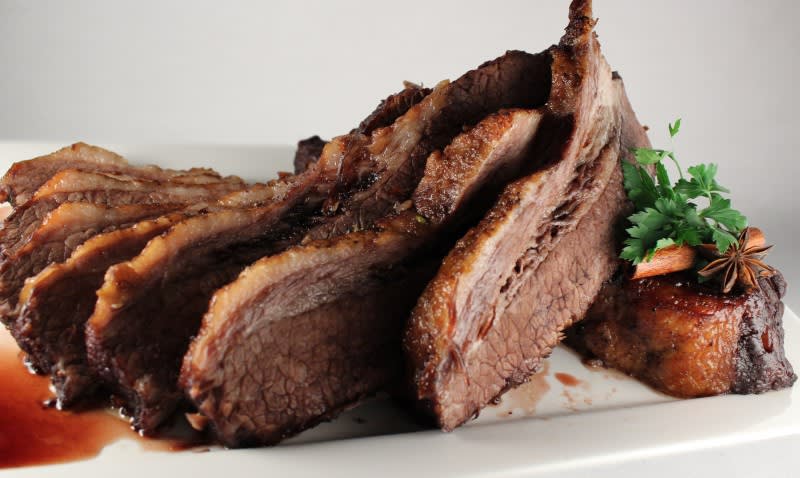
Around this time of year, when temperatures turn colder, I start to think about foods that warm my family from inside out. It’s braising weather.
Jewish home cooks are expert at braising. Our briskets are famous, aren’t they? Everyone has a favorite recipe, usually passed down from grandma or whoever the great cook was in your family.
But this same cooking method that makes our briskets so congenial is one that you can use to make a winterful of delicious family meals using other cuts of meat. I often choose lamb shanks; they’re perfect for those homey slow-cooked, cold weather family dinners.
The beauty of lamb shanks is, ironically, what makes them a so-called “lesser-cut” of meat. Shanks have lots of gristly fibers. But this connective tissue softens when cooked slowly and surrounded by moisture. The gelatin they contain breaks down and melts into rich, glossy sauce.
Another reason I like lamb shanks is that, like other braised foods, they taste better when made a day or so ahead. The flavors seem to mix and mellow with time and, after being refrigerated, excess cooking fat rises to the surface so I can remove it easily. The big bonus here is that I can cook the shanks on the weekend and pop them into the oven a day or so later when I’m too busy to cook. It’s a big time saver.
If you need any more convincing, think about this: lamb shanks are a lot cheaper than the more tender steaks and chops that cook quickly. Who would complain about saving money these days?
Braising is a fairly straightforward technique: brown the shanks, add seasonings and some liquid to the pan, then let the ingredients cook, covered, at low heat for a few hours until the meat is tender. As the dish cooks the aroma of food simmering under the dark cover of a pot gives off heady cooking vapors and extra heat for the household. I always get smiles of eager anticipation of a great dinner, and so will you.
Some home cooks don’t bother with the first browning step, but I think it’s worth the fuss because the lightly crisped outside gives the entire dish a boost of flavor. Sometimes I sprinkle the meat with flour before browning the meat. This enriches the color and helps to thicken the sauce.
If you decide to brown the meat, here’s a tip: make sure the surface is dry (wipe it with paper towels) to avoid sputtering, and use a large pan. If the pan is too small the meat will steam rather than brown.
The liquid I add to the braising pot depends on the seasonings and other ingredients in the recipe. Sometimes my family is in the mood for a very simple dish. In that case I’ll pour in some wine, stock or beer, add a few sprigs of fresh thyme or rosemary, and include vegetables such as carrots, potatoes and parsnips.
But we usually like a dish with a little more zing, with flavors that make the meal more exciting. Maybe with Moroccan or Indian seasonings or with a flash of fiery red hot pepper. The two recipes I’ve given are among our favorites. The Braised Lamb Shanks, Catalan Style, is typically Spanish, and includes a trace of unsweetened chocolate, providing just enough bitterness to complement the sweet cinnamon and orange peel. I serve it with rice, egg noodles or white beans. Braised Lamb Shanks with Dried Apricots and Fragrant Spices is more Middle Eastern in style; it bursts with bright flavors and the dried apricots give it a tangy quality. Couscous or polenta are good accompaniments.
I know that home cooks have steadfast opinions about whether brisket, lamb shanks or any other braised food should go in the oven or on the cooktop. Frankly, either will do, but the oven method is easier and more efficient because the heat is evenly distributed. If you prefer the cooktop, be sure the heat is on low. Most recipes suggest oven heating at 350 degrees, but I prefer gentler heat (275 degrees), even if the dish takes longer to finish. The meat comes out so soft and juicy it’s worth the wait.

Ronnie Fein has been a freelance food and lifestyle writer since 1980. She currently writes regular features for the food and community sections of daily newspapers and has written articles for Newsday, Cook’s Illustrated, Consumer’s Digest, Connecticut magazine, and many other publications. She operates the Ronnie Fein School of Creative Cooking in Stamford, Connecticut and is the author of three cookbooks, the most recent is
Hip Kosher (DaCapo, 2008).
The words of this author reflect his/her own opinions and do not necessarily represent the official position of the Orthodox Union.
